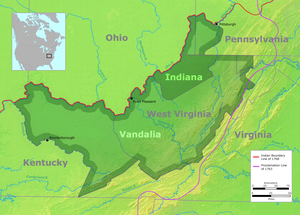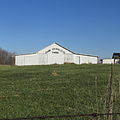حرب اللورد دونمور
| حرب اللورد دونمور | |||||||||
|---|---|---|---|---|---|---|---|---|---|
| جزء من حرب الستين عاما | |||||||||
 |
|||||||||
| |||||||||
 |
|||||||||
| تعديل مصدري - تعديل | |||||||||
39°55′05″N 80°48′17″W / 39.918°N 80.8048°W حرب اللورد دونمور — أو حرب دونمور — كانت صراعًا عام 1774م بين مستعمرة فيرجينيا وقبائل شاوني وشعوب المينغو الأمريكية الهندية.
وكان حاكم فيرجينيا هو جون موراي، الإيرل الرابع لدونمور - اللورد دونمور. وطلب من مجلس نواب فيرجينيا إعلان حالة الحرب مع الشعوب الهندية المعادية واستدعاء قوة ميليشيات نخبوية تطوعية للقيام بهذه الحملة.
ونتج الصراع عن العنف المتصاعد بين المستعمرين البريطانيين، الذي كانوا وفقًا لمعاهدات سابقة يستكشفون ويتحركون إلى أراضٍ جنوب نهر أوهايو (ولاية فرجينيا الغربية وكنتاكي حديثًا) والهنود الحمر، والذين كانو يتمتعون بحقوق بموجب معاهدات للصيد في هذه الأماكن. من وادي أوهايو الأعلى، يكتب جورج واشنطن مقيِّمًا نهر إليجيني في يومياته عن يوم السبت 17 نوفمبر 1770م، «إن الهنود وكذا نساءهم يتمتعون بإتقان إدارة الزوارق وإقامة مخيمات وكبائن الصيد على طول النهر لتسهيل نقل جلودهم عن طريق النهر إلى السوق.»
ونتيجة للهجمات المتتالية من قِبل الهنود الذين يقومون بالصيد ومجموعات الحرب على المستوطنين، تم إعلان الحرب «لتهدئة مجموعات الحرب الهندية المعادية». وقد انتهت الحرب بعد وقت قصير بعد انتصار فيرجينيا في معركة بوينت بليزانت في 10 أكتوبر 1774م.
ونتيجة لهذا الانتصار، خسر الهنود الحق في الصيد في المنطقة ووافقوا على الاعتراف بأن يكون نهر أوهايو هو الحد بين أراضي الهنود والمستعمرات البريطانية.
وعلى الرغم من أن شيوخ القبائل الهندية وقعوا على المعاهدة، فإنه سرعان ما اندلع الصراع داخل الأمم الهندية. وشعر بعض رجال القبائل أن المعاهدة قضت على حقوقهم وعارضوها، واعتقد آخرون أن اندلاع حرب أخرى سوف تعني فقط تكبد خسائر إضافية من الأراضي لصالح المستعمرين البريطانيين الأكثر قوة.
وعندما اندلعت الحرب بين المستعمرين والحكومة البريطانية، سرعان ما اكتسبت أطراف الحرب من الشعوب الهندية مزيدًا من القوة. وقاموا بحشد مختلف الشعوب الهندية لمهاجمة المستعمرين أثناء الحرب الثورية.
معلومات تاريخية[عدل]

منذ فترة طويلة، ادعى اتحاد الأوريكيين الحق في المنطقة الموجودة جنوب نهر أوهايو. وعلى الرغم من أن اتحاد الأوريكيين كان أقوى أمة هندية في المستعمرات الشمالية، ادعت قبائل أخرى حقها أيضًا في المنطقة واصطادت في كثير من الأحيان في المنطقة. وكانت مقاطعة أوهايو من أسباب اندلاع حرب السنوات السبع بين فرنسا وبريطانيا، والتي انتهت بتنازل فرنسا عن السيطرة على كامل المنطقة بموجب معاهدة باريس عام 1763م.
وعندما حصل المسؤولون البريطانيون على الأرض الواقعة جنوب نهر أوهايو بموجب معاهدة فورت ستانويكس عام 1768م من شعوب الإيروكوا، رفض هنود أوهايو الذين كانوا يصطادون في هذه الأرض التوقيع على المعاهدة واستعدوا للدفاع على حقوق الصيد الخاصة بهم.[1]
وفي طليعة هذه المقاومة كانت قبيلة شاوني. وكانت هذه القبيلة أقوى القبائل بين قبائل الهنود الحمر المناهضة للإيروكوا. وسرعان ما نظموا تحالفًا من القبائل الهندية الفيدرالية الذين كانوا يعارضون البريطانيين والإيروكوا من أجل فرض مطالبهم.[2] وعمل المسؤولون البريطانيون والإيروكوا على عزل قبيلة شاوني دبلوماسيًا عن الأمم الهندية الأخرى. وعندما اندلعت حرب اللورد دونمور عام 1774، واجهت قبيلة شاوني ميليشيات فيرجينيا بعدد قليل من الحلفاء.
عقب معاهدة عام 1768، بدأ المستكشفون والمساحون والمستوطنون البريطانيون في التدفق على المنطقة.[3](طالع فندليا (مستعمرة)[4]
وفي سبتمبر عام 1773، قاد صياد غامض يُدعى دانيال بون مع مجموعة من حوالي 50 مهاجرًا في أولى محاولات المستعمرين البريطانيين لإقامة مستوطنة في مقاطعة كنتاكي، فيرجينيا. وفي 9 أكتوبر 1773، تمت مهاجمة الابن الأكبر لبون الذي يُدعى جيمس ومجموعة صغيرة من الرجال والفتيان الذين كانوا يستعيدون الإمدادات التي تم الحصول عليها من خلال هجمات قامت بها عصابة من ديلويرس والشاونيين والشيروكيين. وقرروا أن «يرسلوا رسالة بمعارضتهم للاستيطان …» [5] تم أسر جيمس بون وصبي آخر تم تعذيبهما حتى الموت. كما صدموا من وحشية القتل التي واجهها للمستوطنون السابقين على طول الحدود، وتخلت مجموعة بون عن رحلتها.
معرض صور[عدل]
ملاحظات[عدل]
- ^ "I likewise advised them to withdraw the Senecas of Ohio from thence and settle them nearer their natural friends as at present by their Connections with others they bring disgrace & suspicion on their own confederacy, and this I was the readier induced to do, as Kayashota the chief of those on Ohio, a man of universal influence was present & had privately assured me that it was agreeable to him." Sir William Johnson to the Earl of Dartmouth, (Johnson Hall, Nov. 4, 1772) Johnson, Sir William in: Documents, Relative to the Colonial History of the State of New York (Lon.Docs.: XLIII), vol. VIII, pp. 314-317. 1996, Glenn Black Laboratory of Archaeology and The Trustees of Indiana University http://www.gbl.indiana.edu/archives/miamis19/M71-73_30a.html نسخة محفوظة 11 مارس 2009 على موقع واي باك مشين.
"Indian Business at present of most Moment is the Northern and Western Confederacies. The Northern Nations ceded Tracts of Land at the Treaty of Fort Stanwix, inconvenient to the Indians of the Ohio, which exasperated them to a great Degree, but finding themselves too weak alone for the six Nations, they have been, and appear still to be endeavoring to form a general Union of all the Western & Southern Nations, and the Shawnese are supposed to be the Contrivers of the Scheme. The six Nations in Return have strengthened their Alliance with the Canada and other Tribes. The six Nations have by Deputy's sent to Scioto threatened much, but Nothing has been undertaken openly on either Side...It has very often been reported, that the French and Spaniards have excited the Nations against the English, and been the Authors of many Mischiefs, tho' it has not been discovered that the Spanish Government has had any Concern therein. But it is probable the Traders at the Illinois as well British, as Spanish Subjects have been guilty of such iniquitous Practices to keep the trade to themselves...", Gage to Haldimand, New York June 3d 1773, Gage, Thomas in: Library of Congress, British Museum, Additional MS. 21665, f. 141-142. THE OHIO VALLEY-GREAT LAKES ETHNOHISTORY ARCHIVES: THE MIAMI COLLECTION, 1996, Glenn Black Laboratory of Archaeology and The Trustees of Indiana University http://www.gbl.indiana.edu/archives/miamis19/M71-73_39a.html نسخة محفوظة 11 مارس 2009 على موقع واي باك مشين. - ^ Dowd, Spirited Resistance, 42–43.
- ^ Letter to the Earl of Dartmouth, (Johnson Hall, Sept. 22, 1773), Johnson, Sir William in: Docs. Rel. to the Col. Hist. of the State N. Y. (London Docs.: XLIII): VIII, pp. 395-397 and in The Papers of Sir William Johnson, vol. 8, pp. 888-891. 1996, Glenn Black Laboratory of Archaeology and The Trustees of Indiana University http://www.gbl.indiana.edu/archives/miamis19/M71-73_43a.html نسخة محفوظة 11 مارس 2009 على موقع واي باك مشين.
- ^ "The Shawanese on the whole appear at present the most attentive to the Six Nations Councils of any to the Southward, but they are much alarmed at the numbers who go from Virginia &c in pursuit of new settlements leaving large Tracts of Country unsettled behind them, and who I am sorry to find an not be restrained being numerous, & remote from the influence and Seats of Government, and the old claims of Virginia conspiring to encourage them, so long as they confine themselves within the ceded Tract...I gave them of His Majestys Intentions to form a Colony on Ohio, and of the evacuating of Fort Pitt, that they were very thankfull for the whole they had thereof and hoped (page 890) that the person appointed to govern there would prove a wise man and restrain the abuses in Trade & irregularities committed by the Frontier Inhabitants,..." Sir Johnson Letter to the Earl of Dartmouth, (Johnson Hall, Sept. 22, 1773), Johnson, Sir William in: Docs. Rel. to the Col. Hist. of the State N. Y. (London Docs.: XLIII): VIII, pp. 395-397, and in The Papers of Sir William Johnson, vol. 8, pp. 888-891. 1996, Glenn Black Laboratory of Archaeology and The Trustees of Indiana University http://www.gbl.indiana.edu/archives/miamis19/M71-73_43a.html نسخة محفوظة 11 مارس 2009 على موقع واي باك مشين.
- ^ John Mack Faragher, Daniel Boone
المراجع[عدل]
- Crumrine, Boyd. History of Washington County, Pennsylvania With Biographical Sketches of Many of Its Pioneers and Prominent Men. Philadelphia: L. H. Everts & Co., 1882.
- Dowd, Gregory Evans. A Spirited Resistance: The North American Indian Struggle for Unity, 1745–1815. Baltimore: Johns Hopkins University Press, 1992. ISBN 0-8018-4609-9.
- Downes, Randolph C. Council Fires on the Upper Ohio: A Narrative of Indian Affairs in the Upper Ohio Valley until 1795. Pittsburgh: University of Pittsburgh Press, 1940. ISBN 0-8229-5201-7 (1989 reprint).
- Faragher, John Mack. Daniel Boone: The Life and Legend of an American Pioneer. New York: Holt, 1992; ISBN 0-8050-1603-1.
- Hintzen, William. The Border Wars of the Upper Ohio Valley (1769–1794). Manchester, CT: Precision Shooting Inc., 2001. ISBN 0-9670948-0-1
- Lewis, Virgil A. History of the Battle of Point Pleasant. Charleston, West Virginia: Tribune, 1909. Reprinted Maryland: Willow Bend, 2000. ISBN 1-888265-59-0.
- Lofaro, Michael. Daniel Boone: An American Life. Lexington, KY: University Press of Kentucky, 2003; ISBN 0-8131-2278-3. Previously published (in 1978 and 1986) as The Life and Adventures of Daniel Boone.
- Randall, E. O. The Dunmore War. Columbus, Ohio: Heer, 1902.
- Skidmore, Warren and Donna Kaminsky. "Lord Dunmore's Little War of 1774: His Captains and their Men who Opened Up Kentucky & the West to American Settlement". Bowie, Maryland: Heritage Books, Inc., 2002. ISBN 0-7884-2271-5.
- Smith, Thomas H., ed. Ohio in the American Revolution: A Conference to Commemorate the 200th Anniversary of the Ft. Gower Resolves. Columbus: Ohio Historical Society, 1976.
- Sugden, John. Blue Jacket: Warrior of the Shawnees. Lincoln and London: University of Nebraska Press, 2000. ISBN 0-8032-4288-3.
- Thwaites, Reuben Gold and Louise Phelps Kellogg, eds. Documentary History of Dunmore's War, 1774. Madison: Wisconsin Historical Society, 1905. Reprinted Baltimore: Clearfield, 2002. ISBN 0-8063-5180-2.
- Emilius Oviatt Randall, Daniel Joseph Ryan. History of Ohio: the rise and progress of an American state, Volume 2. The Century History Company, 1912 [1] Public Domain downloadable.



